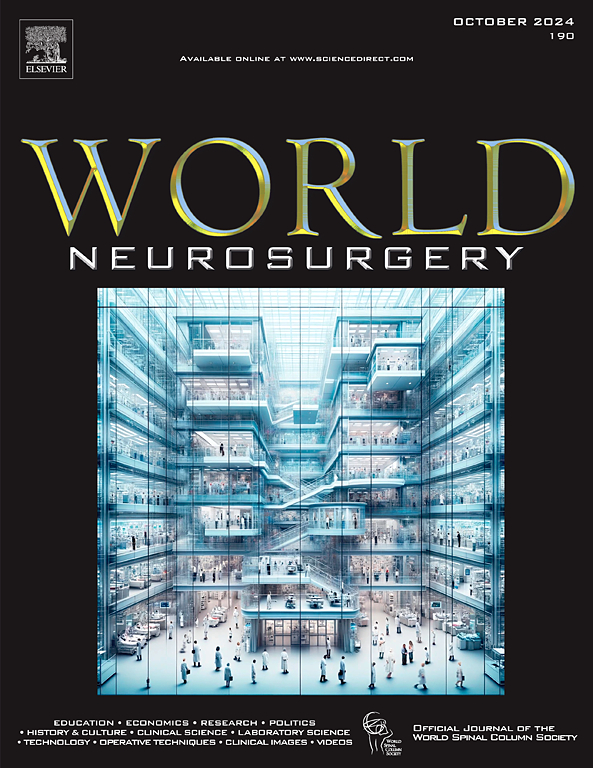Co-Cr-Mo导向多向滑动生长棒联合根尖控制技术治疗重度刚性早发性脊柱侧凸。
IF 1.9
4区 医学
Q3 CLINICAL NEUROLOGY
引用次数: 0
摘要
目的:探讨Co-Cr-Mo引导下多向滑动生长棒技术(CMSG)联合根尖控制技术(ACTs)治疗重度刚性早发性脊柱侧凸(EOS)的疗效及并发症。方法:应用CMSG联合ACTs治疗22例重度刚性EOS患者。记录手术细节及并发症,测量Cobb角、根尖椎偏移量、T1-S1垂直高度。结果:所有患者随访24-144(66.8±29.6)个月。与术前相比,首次手术后冠状Cobb角、首次手术后冠状顶椎偏移量、末次随访时T1-S1垂直高度均有改善(p结论:CMSG联合ACTs可有效矫正重度刚性EOS患者脊柱侧凸并控制其进展,保留脊柱生长潜能,并发症发生率低于传统生长棒手术。本文章由计算机程序翻译,如有差异,请以英文原文为准。
Treatment of Severe Rigid Early-Onset Scoliosis with Co-Cr-Mo Guided Multidirectional Sliding Growth Rod Combined with Apical Control Techniques
Objective
To explore the efficacy and complications of the Co-Cr-Mo guided multidirectional sliding growth rod technique (CMSG) combined with apical control techniques (ACTs) in the treatment of severe rigid early-onset scoliosis (EOS).
Methods
Twenty-two patients with severe rigid EOS were treated with the CMSG combined with ACTs. The surgical details and complications were recorded, and the Cobb angle, apical vertebra offset, and T1-S1 vertical height were measured.
Results
All patients were followed up for 24–144 (66.8 ± 29.6) months. The coronal Cobb angle after the first surgery, the coronal apical vertebra offset after the first surgery, and the T1–S1 vertical height at the last follow-up were all improved compared with those before surgery (P < 0.05). The postoperative orthopedic effect was relatively satisfactory, and there was no aggravation of scoliosis. Complications occurred in 6 cases, including 1 case of rod fracture, 1 case of screw loosening, 2 cases of proximal junctional kyphosis, 1 case of trunk balance decompensation, and 1 case of local infection.
Conclusions
The CMSG combined with ACTs can effectively correct scoliosis and control its progression in patients with severe rigid EOS, preserve the growth potential of the spine, and has a lower complication rate than traditional growth rod surgery.
求助全文
通过发布文献求助,成功后即可免费获取论文全文。
去求助
来源期刊

World neurosurgery
CLINICAL NEUROLOGY-SURGERY
CiteScore
3.90
自引率
15.00%
发文量
1765
审稿时长
47 days
期刊介绍:
World Neurosurgery has an open access mirror journal World Neurosurgery: X, sharing the same aims and scope, editorial team, submission system and rigorous peer review.
The journal''s mission is to:
-To provide a first-class international forum and a 2-way conduit for dialogue that is relevant to neurosurgeons and providers who care for neurosurgery patients. The categories of the exchanged information include clinical and basic science, as well as global information that provide social, political, educational, economic, cultural or societal insights and knowledge that are of significance and relevance to worldwide neurosurgery patient care.
-To act as a primary intellectual catalyst for the stimulation of creativity, the creation of new knowledge, and the enhancement of quality neurosurgical care worldwide.
-To provide a forum for communication that enriches the lives of all neurosurgeons and their colleagues; and, in so doing, enriches the lives of their patients.
Topics to be addressed in World Neurosurgery include: EDUCATION, ECONOMICS, RESEARCH, POLITICS, HISTORY, CULTURE, CLINICAL SCIENCE, LABORATORY SCIENCE, TECHNOLOGY, OPERATIVE TECHNIQUES, CLINICAL IMAGES, VIDEOS
 求助内容:
求助内容: 应助结果提醒方式:
应助结果提醒方式:


